"Here & There in Tokyo - February 2009"
- Yurakucho, Shinjuku, Shinagawa, Ginza, Yotsuya, etc. -
by Lyle (Hiroshi) Saxon - Images Through
Glass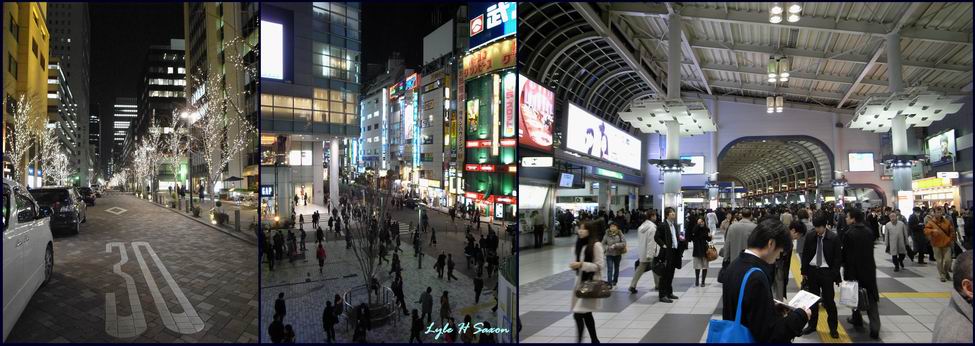 The days, weeks, months, years, & decades go by. Centuries go by as well, but - unfortunately - that's beyond our immediate intellectual grasp and ability to experience. There's something about this batch of pictures that produces a mix of simultaneous feelings - philosophical..., amazement, frustration & contentment, among other indefinable elements. I can't pin it down, but I can point out that the three scenes above of - from left to right - Yurakucho, Shinjuku, and Shinagawa are radically different from when I first saw them a quarter of a century ago.  This winter I attended several get-togethers with friends and/or colleagues at various eating/drinking establishments (izakaya) here and there in Tokyo (Jiyugaoka, Shinagawa, etc.). Looking at these pictures now, I wonder if they represent the last of an easy and stable era. With rougher financial seas dead ahead, the luxury of eating out will likely be something I will not often engage in.  The winter may be the best time to meet people in an izakaya (or restaurant, pub, coffee shop, whatever), as being warm inside - out of the cold - is a welcome feeling, and adds to the pleasure of the get-together, but... after it's over, there's the cold journey home under a long and unbroken chain of florescent tubes. (Note to future readers who have not experienced the unpleasant throbbing glare of florescent tubes: Whatever may have become worse in the world since the year 2009, at least be thankful for healthier and vastly less irritating lighting! Surely better lighting has come to the future - I can't believe the nasty glare of florescent tubes will live on and on and on.)  Above & below - the florescent tubes - always the florescent tubes. Below - an older platform roof, probably not long for this world. This older type is being replaced station by station. Nothing wrong with the new roofs, but there is a character to the old ones. Is it a character born of the more complicated lines and design, or something about history having soaked into the structure, making it more real somehow than the new ones? 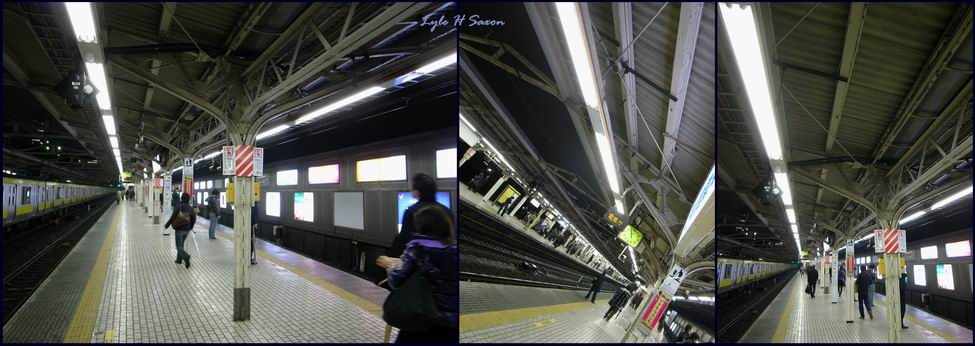 (Below - left & center) - Ginza. Specifically, an old early 1930's building that contains several art galleries. From a European perspective, the building may not be so interesting, but it's fascinating to me - having gotten used to(?) the relentless pace of reconstruction in this city. It seems as though any building older than 20 years is looked upon as ripe for demolition, and there is that 70+ year-old building still there! In Tokyo, it might as well be 700 years old - it really stands out in The City of New. (Below - right) - A close-up of a park bench in a small park in Ota-ku. I like the way they leave the old paint on each time the bench is repainted. It's becoming a historical and artistic bench! 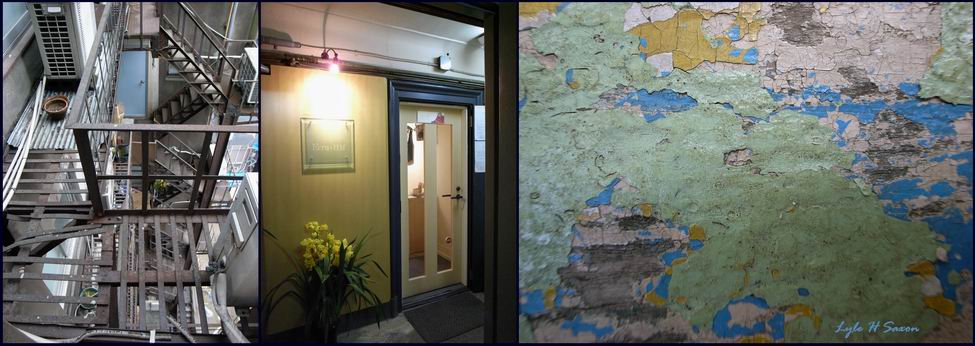 (Below - all three). Waiting for trains - one of the times to send e-mails with a cell phone. For many people in Tokyo, they do a large part of their text messaging on train platforms and inside of trains. It's probably just because I'm not used to it, but it seems like it's easier to write sentences in Japanese than in English, as the auto-complete - not only for words, but for whole sentences - works really well. Also, there is no upper and lower case in Japanese, so you only have to cycle through the characters - with one for each type instead of two. Nevertheless, I hate wasting time writing messages on my cell phone when they can be done so much more quickly with a proper keyboard.  (Below - all three) - One overcast winter's day. The scene on the left is not something to be taken for granted in this city of buildings. As a child, I grew up with trees, and was fascinated with tall buildings - now I live & work among tall buildings and am fascinated by the not-so-common sight of the sky seen through tree branches.... 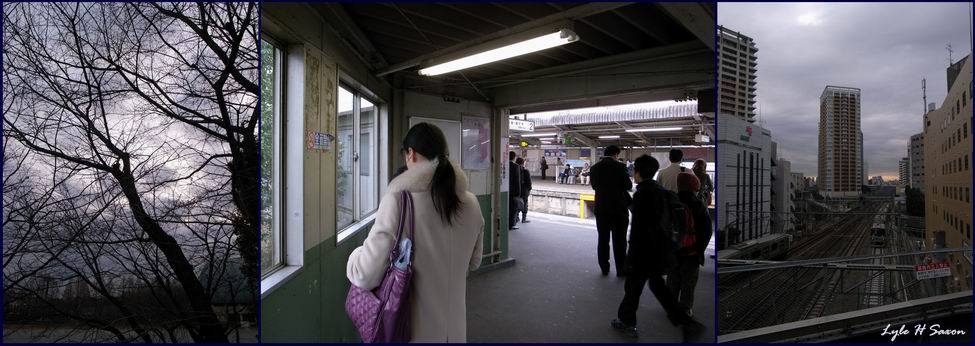 (Below - all three) - Tokyo has an extensive subway system in the center of the city, but for trains heading out to the burbs from the central area (pretty well defined by the Yamanote loop line), most of them are surface trains. I much prefer riding on surface trains, since you can actually see the world going by outside, and not just a tunnel wall.  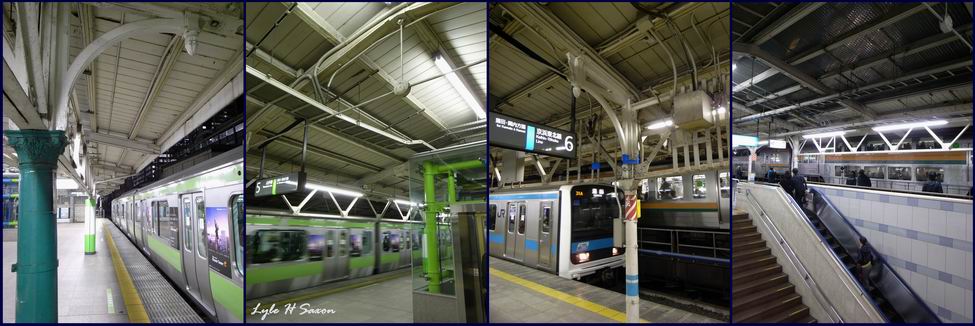 (Above - all four; Below - right) - Tokyo Station. Some views of an older part of the station. Most of the platforms and platform roofs at Tokyo Station have been renovated over the past twenty years, so I like looking up and seeing the older parts of this platform. The mix of old and new at Tokyo Station makes it more interesting than if it were one or the other. (The old brick building part of the station on the Marunouchi side of the station is currently being earthquake... strengthened - a very rare case of something old being preserved in this city.)  (Above left) - One rainy evening in Ota-ku. The red lantern (akachochin) indicates a drinking place, or izakaya - which is what the three characters say. (Don't confuse "red lantern" with "red light" - there is no connection... not in this century in any case.) From what I hear from westerners living outside Japan, "izakaya" in English has a narrower definition, but from what I've seen while living here in Japan, it simply means a drinking place that is a cross between a Japanese pub and a restaurant. And in spite of the red lantern actually saying "izakaya", it's been my experience that the akachochin places are small drinking establishments with simple menus that are known as akachochin, and izakaya more often refers to larger places with no red lanterns and a more extensive range of food and drink. (Above center) - Another house bites the dust. The cost of land is considerably higher than the cost of a house, so the usual procedure for a new home-owner is to: 1) Buy a house & land. 2) Tear down the old house. 3) Let the land sit there empty for a few weeks. 4) Build a new house. As even nice houses are torn down, there seems to almost be a taboo against moving into a used house (if you're the owner that is - renting is another matter of course).  (Above and below) - Tokyo, Ebisu, & Shinjuku. These are all typical scenes in Tokyo. Semi-old, new, under construction, buildings and lights everywhere. Incidentally, I've been asked why so many of my pictures were taken at night. Basically for two reasons: 1) Tokyo is in the wrong time zone, so it gets dark an hour or two earlier than it should. 2) Generally, I'm at a desk job in the daytime, so by the time I get off work (and can begin taking pictures), the sun has gone.  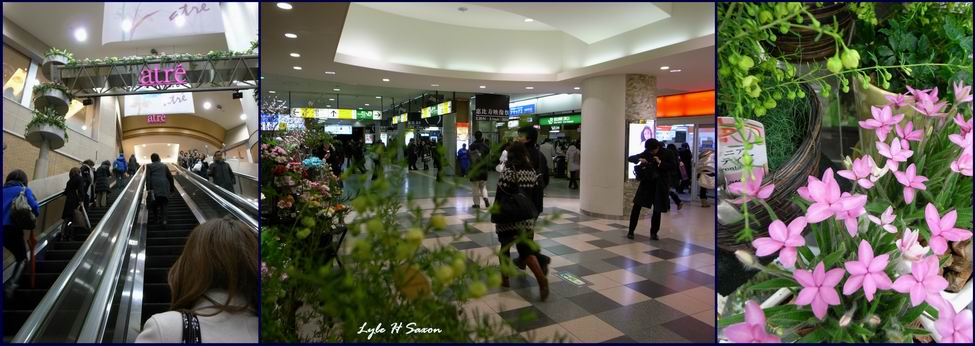 (Above - all three) - Ebisu. (Below) - More day-to-day stuff. Riding trains in the daytime and at night (at an average of from one to four hours a day, five or six days a week, I have spent a lot of time on the train system over the past twenty-five years). (Below center) - The aftermath of another get-together at another izakaya.   (Above and below) - Here and there... At a Japanese pub, and then an Irish pub, with the trains and train stations between. (Below center) - I don't actually remember exactly where I took that, but I think it's Yurakucho Station. Certainly the center photo above is Shinagawa Station. Incidentally, both Irish and English pubs are popular in Tokyo. (I'm ashamed to admit it, but I'm not always sure which is which here - they both have similar decor, drinks, and food. Here in Tokyo that is - I've never been to a pub in England or Ireland.) 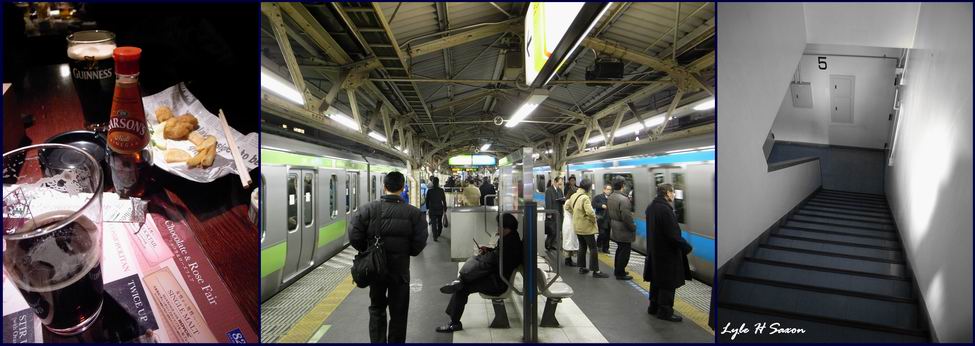  (Above left & right) - Yotsuya in the rain. (Below 2nd from left) - This picture is from over 100 years ago. Aside from just liking the photo, it's so atypical of every other picture I've seen of people taken in that time frame, I'm quite impressed with the bold artistry of it! Smashing a hole in shoji and then posing the woman with her hair down and loose. It's quite an amazing photo - I wish I could go back in a time machine to meet both the photographer and the model. Photography was in black and white then of course, but many photos taken in Japan at that time were very skillfully hand colored, and some of them really look like real color photos. This particular one mainly just looks like a sepia tone (except for the purple kimono), but some outdoor photos from this era have quite amazing coloring. I'm trying to find out who took this photo, but so far I only know that it was probably taken shortly before 1900. (Below 3rd from left) - I know everything there is to know about this photo! I know where it was taken, what it is, how it was taken, etc., but I'll leave it as a mystery. I will say this however - it's an authentic photograph. It was not a PhotoShop creation, but rather just something I captured with a camera.   (Above left and center) - Ebisu - looking out from the elevated station area. (Below left and center) - A truck cab. Many truck cabs here remind me of computer cubicles in offices, with personal stuff piled up around the work area, which is the driver's seat in this case.  (Above right) - A communications pillar on a platform at Shinjuku Station. (Below left) - One of the new platform connecting passageways at Shinjuku Station, this one from the Southern Terrace area. (Below center) - One of the old Chuo Line trains, made around 1982. Over the past year, they've been phasing these out, and there are only a few left now. The new ones are generally good I suppose, but the old ones are better in one very important way - they have much better air. The new ones are sealed boxes that are no doubt energy efficient, but the air tends to be stale inside (compared to the old ones in any case - it all depends on what you compare it to). It should be noted that even in the newer trains, the central windows can be opened halfway, but very rarely does anyone risk irritating sealed-box lovers by actually opening one.  Copyright 2009 by Lyle (Hiroshi) Saxon, Images Through Glass, Tokyo - All rights reserved |